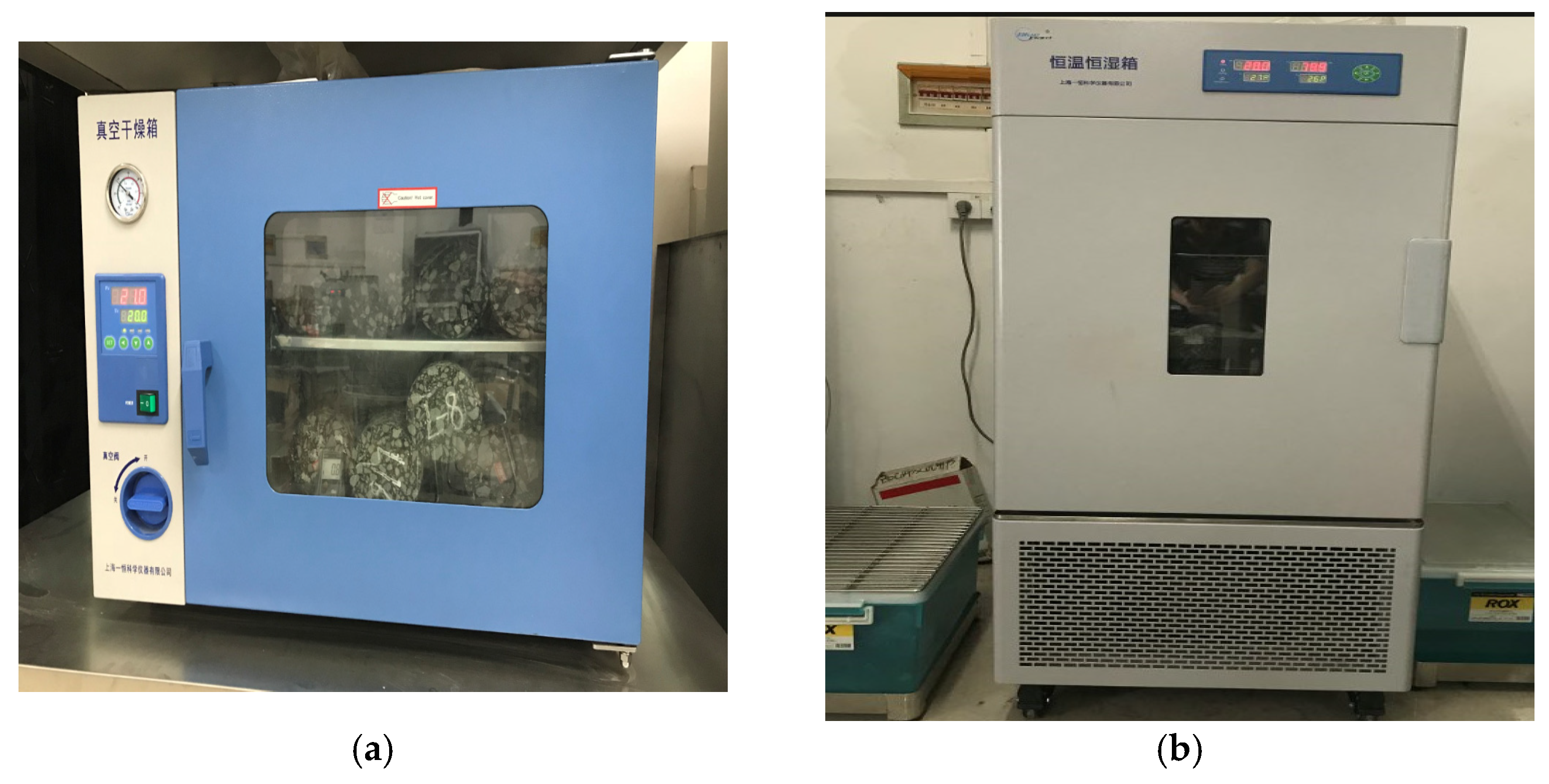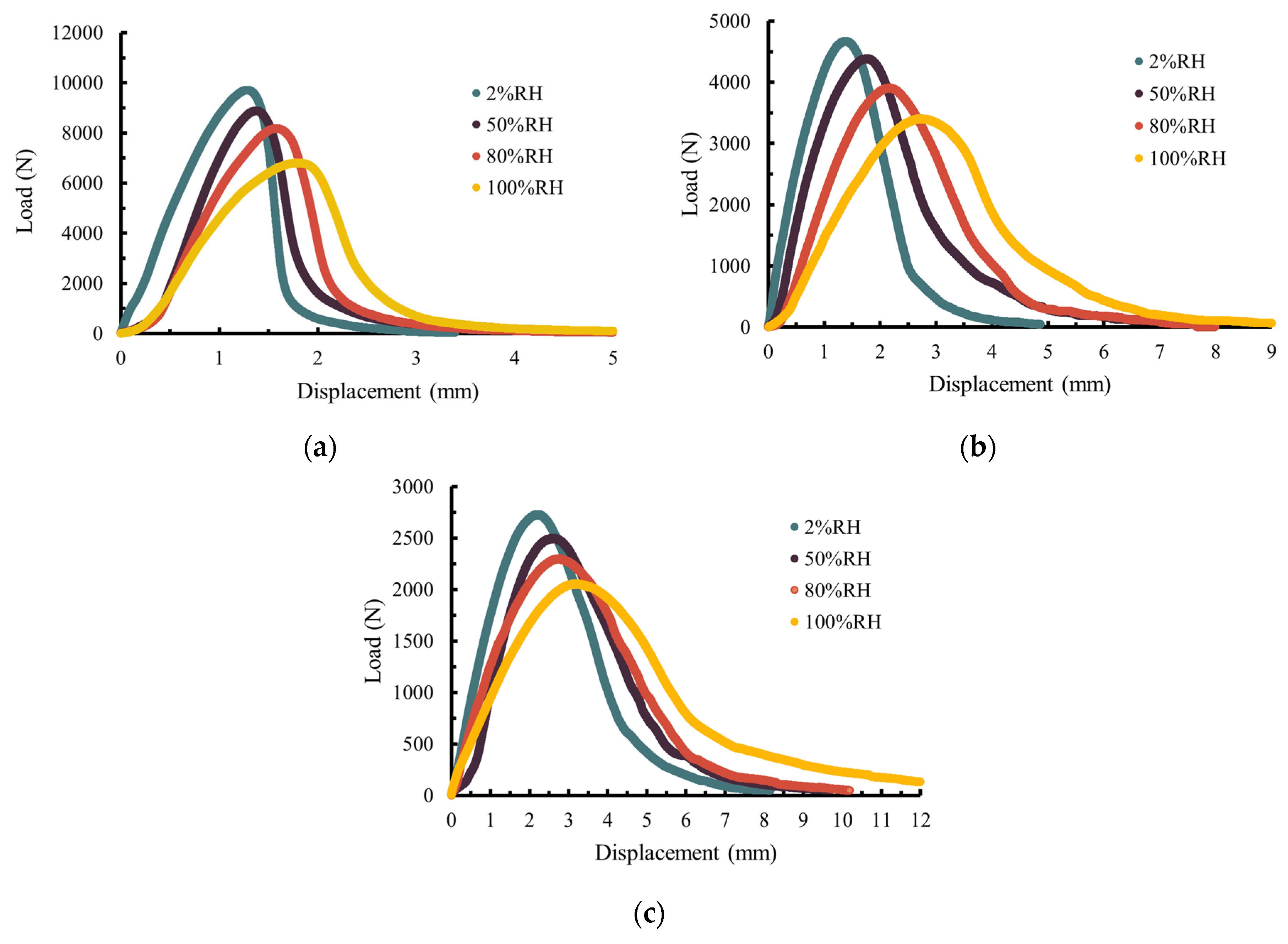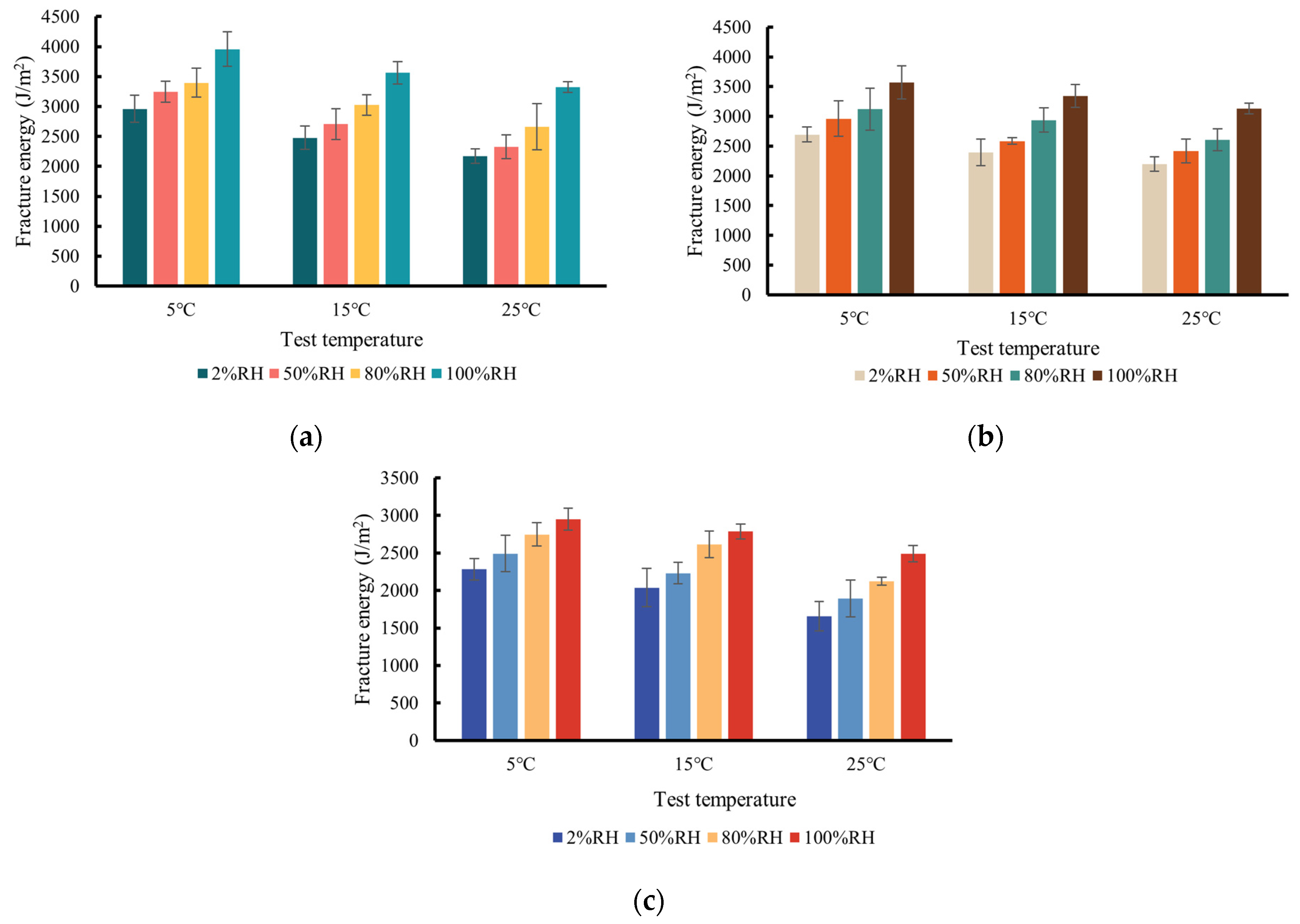Experimental Investigation of Water Vapor Concentration on Fracture Properties of Asphalt Concrete
Abstract
:1. Introduction
2. Materials and Methods
2.1. Materials
2.2. Sample Preparation
2.3. Humidity Conditioning Program
2.4. Semi-Circular Bending Test
3. Results and Discussion
3.1. Load–Displacement Curve
3.2. Fracture Energy
3.3. Tensile Strength
3.4. Regression Analysis
4. Conclusions
- The humidity conditioning program was designed for the SCB specimens to study the impact of the RH levels of 2%, 50%, 80%, and 100% at 20 °C. The duration of the humidity curing period was determined by the finite element model, which simulated the water vapor diffusion until the equilibrium was reached.
- The load–displacement curve shows that the increase in RH level from 2% to 100% or the elevated temperature from 5 °C to 25 °C decreased the peak load but increased the displacement of the mixtures, which implies that the water vapor or higher temperature reduced the bearing capacity of mixture but improved the mixture toughness.
- The fracture energy showed a downward trend as the temperature increased for the three types of mixtures. Specifically, the AC-13C mixture had the highest fracture energy and showed the best toughness due to its use of the SBS-modified asphalt and higher asphalt content. Therefore, the use modified binders such as SBS-modified asphalt is recommended to enhance the durability of asphalt concrete, especially in regions with high humidity and temperature variations.
- With the rising RH levels, the fracture energy of the three types of mixtures increased since the water vapor enhanced the ductility of the mixture to some extent. Another reason is that the water vapor may alter the internal pore pressure of the mixture and help distribute the stress during loading.
- The tensile strength of the three types of mixtures declined with the increase in temperature, which indicates a reduction in the adhesion of the aggregate–asphalt interface with the higher temperature.
- As the RH level rose from 2% to 100% (i.e., the water vapor concentration rose from 0.35 g/m3 to 17.27 g/m3), the tensile strength of the three types of mixtures was reduced by 34.84% on average, which revealed that the water vapor led to the loss of adhesion and cohesion within the mixture.
- The GEP models were developed to quantify the effect of the water vapor concentration and temperature on the fracture indices. The R-squared values for the GEP models across the three types of mixtures were above 0.94, which indicates a good agreement between the GEP models and the fracture energy and tensile strength obtained from the SCB test.
Author Contributions
Funding
Institutional Review Board Statement
Informed Consent Statement
Data Availability Statement
Conflicts of Interest
References
- Luo, R.; Liu, Z.; Huang, T.; Tu, C. Water vapor passing through asphalt mixtures under different relative humidity differentials. Constr. Build. Mater. 2018, 165, 920–930. [Google Scholar] [CrossRef]
- Kassem, E.; Masad, E.; Lytton, R.; Bulut, R. Measurements of the moisture diffusion coefficient of asphalt mixtures and its relationship to mixture composition. Int. J. Pavement Eng. 2009, 10, 389–399. [Google Scholar] [CrossRef]
- Arambula, E.; Caro, S.; Masad, E. Experimental measurement and numerical simulation of water vapor diffusion through asphalt pavement materials. J. Mater. Civ. Eng. 2010, 22, 588–598. [Google Scholar] [CrossRef]
- Kennedy, T.W.; Roberts, F.L.; Lee, K.W. Evaluation of Moisture Effects on Asphalt Concrete Mixtures; Transportation Research Board: Washington, DC, USA, 1983. [Google Scholar]
- Kim, Y.-R.; Zhang, J.; Ban, H. Moisture damage characterization of warm-mix asphalt mixtures based on laboratory-field evaluation. Constr. Build. Mater. 2012, 31, 204–211. [Google Scholar] [CrossRef]
- ASTM D4867; Standard Test Method for Effect of Moisture on Asphalt Concrete Paving Mixtures. ASTM: West Conshohocken, PA, USA, 2006.
- Airey, G.; Collop, A.; Zoorob, S.; Elliott, R. The influence of aggregate, filler and bitumen on asphalt mixture moisture damage. Constr. Build. Mater. 2008, 22, 2015–2024. [Google Scholar] [CrossRef]
- Varveri, A.; Avgerinopoulos, S.; Scarpas, A. Experimental evaluation of long-and short-term moisture damage characteristics of asphalt mixtures. Road Mater. Pavement Des. 2016, 17, 168–186. [Google Scholar] [CrossRef]
- Hossain, M.I.; Tarefder, R.A. Behavior of asphalt mastic films under laboratory controlled humidity conditions. Constr. Build. Mater. 2015, 78, 8–17. [Google Scholar] [CrossRef]
- ASTM E104-20a; Standard Practice for Maintaining Constant Relative Humidity by Means of Aqueous Solutions. ASTM: West Conshohocken, PA, USA, 2012.
- Tong, Y.; Luo, R.; Lytton, R.L. Moisture and aging damage evaluation of asphalt mixtures using the repeated direct tensional test method. Int. J. Pavement Eng. 2015, 16, 397–410. [Google Scholar] [CrossRef]
- Cheng, D.; Little, D.N.; Lytton, R.L.; Holste, J.C. Moisture damage evaluation of asphalt mixtures by considering both moisture diffusion and repeated-load conditions. Transp. Res. Rec. 2003, 1832, 42–49. [Google Scholar] [CrossRef]
- Xi, L.; Luo, R.; Liu, H. Evaluating the influence of humidity on asphalt mixture performance by the flow number test. Constr. Build. Mater. 2021, 284, 122754. [Google Scholar] [CrossRef]
- Lytton, R.L.; Masad, E.A.; Zollinger, C.; Bulut, R.; Little, D.N. Measurements of Surface Energy and Its Relationship to Moisture Damage; Texas Transportation Institute, Texas A&M University: College Station, TX, USA, 2005. [Google Scholar]
- Lee, J.; Moon, S.-J.; Im, J.; Yang, S. Evaluation of moisture susceptibility of asphalt mixtures using dynamic modulus. J. Test. Eval. 2017, 45, 1280–1288. [Google Scholar] [CrossRef]
- Wang, W.; Wang, L.; Yan, G.; Zhou, B. Evaluation on moisture sensitivity of asphalt mixture induced by dynamic pore water pressure. Int. J. Pavement Res. Technol. 2020, 13, 489–496. [Google Scholar] [CrossRef]
- Akentuna, M.; Liu, J.; Mohammad, L.N.; Sachdeva, S.; Cooper, S.B., III; Cooper, S.B., Jr. Moisture Susceptibility of Asphalt Mixtures: Conditioning and Testing Protocols. Transp. Res. Rec. 2023, 03611981221147214. [Google Scholar] [CrossRef]
- Kim, M.; Mohammad, L.N.; Elseifi, M.A. Characterization of fracture properties of asphalt mixtures as measured by semicircular bend test and indirect tension test. Transp. Res. Rec. 2012, 2296, 115–124. [Google Scholar] [CrossRef]
- Kuruppu, M.D.; Chong, K.P. Fracture toughness testing of brittle materials using semi-circular bend (SCB) specimen. Eng. Fract. Mech. 2012, 91, 133–150. [Google Scholar] [CrossRef]
- Li, X.-J.; Marasteanu, M. Using semi circular bending test to evaluate low temperature fracture resistance for asphalt concrete. Exp. Mech. 2010, 50, 867–876. [Google Scholar] [CrossRef]
- Karimi, M.M.; Dehaghi, E.A.; Behnood, A. A fracture-based approach to characterize long-term performance of asphalt mixes under moisture and freeze-thaw conditions. Eng. Fract. Mech. 2021, 241, 107418. [Google Scholar] [CrossRef]
- Fakhri, M.; Ahmadi, A. Evaluation of fracture resistance of asphalt mixes involving steel slag and RAP: Susceptibility to aging level and freeze and thaw cycles. Constr. Build. Mater. 2017, 157, 748–756. [Google Scholar] [CrossRef]
- Zhang, K.; Li, W.; Han, F. Performance deterioration mechanism and improvement techniques of asphalt mixture in salty and humid environment. Constr. Build. Mater. 2019, 208, 749–757. [Google Scholar] [CrossRef]
- JTG E20-2011; Standard Test Methods of Bitumen and Bituminous Mixtures for Highway Engineering. Ministry of Transportation: Beijing, China, 2011.
- JTG F40-2004; Technical Specification for Construction of Highway Asphalt Pavements. Ministry of Transportation Highway Research Institute: Beijing, China, 2004.
- Marín-Uribe, C.R.; Restrepo-Tamayo, L.M. Experimental study of the tensile strength of hot asphalt mixtures measured with indirect tensile and semi-circular bending tests. Constr. Build. Mater. 2022, 339, 127651. [Google Scholar] [CrossRef]
- Tu, C.; Luo, R.; Huang, T. Numerical Simulation of Moisture Diffusion in the Microstructure of Asphalt Mixtures. Materials 2023, 16, 2504. [Google Scholar] [CrossRef] [PubMed]
- EN 12697-44; Czech Standardization Agency. Bituminous Mixtures-Test Methods for Hot Mix Asphalt Part 44: Crack Propagation by Semi-Circular Bending Test. BSI: London, UK, 2019.
- Huang, L.; Cao, K.; Zeng, M. Evaluation of semicircular bending test for determining tensile strength and stiffness modulus of asphalt mixtures. J. Test. Eval. 2009, 37, 122–128. [Google Scholar] [CrossRef]
- Ferreira, C. Gene Expression Programming: Mathematical Modeling by An Artificial Intelligence; Springer: Berlin/Heidelberg, Germany, 2006; Volume 21. [Google Scholar]









| Properties | Unit | Test Value | Specification | |
|---|---|---|---|---|
| Penetration (25 °C, 5 s, 100 g) | 0.1 mm | 55.0 | 40~60 | |
| Ductility (5 °C, 5 cm/min) | cm | 27.0 | ≥20 | |
| Softening point (TR&B) | °C | 76 | ≥75 | |
| Density | g/cm3 | 1.03 | - | |
| TFOT | Loss in mass | % | 0.10 | ≤±1.0 |
| Reduction penetration (25 °C) | % | 71.0 | ≥65 | |
| Ductility (5 °C, 5 cm/min) | cm | 17.0 | ≥15 | |
| Properties | Unit | Test Value | Specification | |
|---|---|---|---|---|
| Penetration (25 °C, 5 s, 100 g) | 0.1 mm | 68.0 | 60~80 | |
| Ductility (5 °C, 5 cm/min) | cm | 36.0 | ≥20 | |
| Softening point (TR&B) | °C | 47.0 | ≥46 | |
| Density | g/cm3 | 1.04 | - | |
| TFOT residue | Loss in mass | % | 0.03 | ≤±0.8 |
| Reduction penetration (25 °C) | % | 75.0 | ≥61 | |
| Ductility (10 °C, 5 cm/min) | cm | 15.0 | ≥6 | |
| Mixture Properties | AC-13C | AC-20C | AC-25C | |||
|---|---|---|---|---|---|---|
| Value | Specification | Value | Specification | Value | Specification | |
| Optimal asphalt content | 4.8 | — | 4.5 | — | 3.9 | — |
| Bulk specific gravity (g/cm3) | 2.412 | — | 2.457 | — | 2.492 | — |
| Maximum specific gravity (g/cm3) | 2.694 | — | 2.571 | — | 2.586 | — |
| Air void (Va)/% | 4.0 | 3~5 | 4.4 | 4~6 | 5.2 | 4~6 |
| Air void in mineral aggregate (VMA)/% | 14.6 | ≥14 | 14.0 | ≥13 | 12.1 | ≥12 |
| Air void filled with asphalt (VFA)/% | 71.3 | 65~75 | 68.4 | 65~75 | 69.7 | 65~75 |
| Marshall Stability/kN | 18.2 | ≥8 | 14.7 | ≥8 | 11.5 | ≥8 |
| Flow value/0.1 mm | 29.54 | 15~50 | 38.4 | 15~50 | 25.5 | 15~50 |
| Mixture Type | Fracture Index | Expression | ||
|---|---|---|---|---|
| AC-13C | Fracture energy | y1 = 0.88x12 − 67.19x1 + 4.65x22 − 15.81x2 + 3204.96 | 0.9821 | 0.0488 |
| Tensile strength | y2 = 0.005x12 − 0.371x1 − 0.058x2 + 8.799 | 0.9431 | 0.0317 | |
| AC-20C | Fracture energy | y1 = −0.54x12 − 16.85x1 + 3.93x22 − 2.53x2 + 2592.53 | 0.9842 | 0.0465 |
| Tensile strength | y2 = −0.008x12 − 0.032x1 − 0.006x22 + 0.015x2 + 8.672 | 0.9560 | 0.0414 | |
| AC-25C | Fracture energy | y1 = −1.64x12 + 17.13x1 + 2.44x22 + 7.57x2 + 2117.36 | 0.9798 | 0.0394 |
| Tensile strength | y2 = 0.007x12 − 0.404x1 − 0.003x22 + 0.001x2 + 7.545 | 0.9491 | 0.0271 |
Disclaimer/Publisher’s Note: The statements, opinions and data contained in all publications are solely those of the individual author(s) and contributor(s) and not of MDPI and/or the editor(s). MDPI and/or the editor(s) disclaim responsibility for any injury to people or property resulting from any ideas, methods, instructions or products referred to in the content. |
© 2024 by the authors. Licensee MDPI, Basel, Switzerland. This article is an open access article distributed under the terms and conditions of the Creative Commons Attribution (CC BY) license (https://creativecommons.org/licenses/by/4.0/).
Share and Cite
Chen, Y.; Huang, T.; Wen, X.; Zhang, K.; Li, Z. Experimental Investigation of Water Vapor Concentration on Fracture Properties of Asphalt Concrete. Materials 2024, 17, 3289. https://doi.org/10.3390/ma17133289
Chen Y, Huang T, Wen X, Zhang K, Li Z. Experimental Investigation of Water Vapor Concentration on Fracture Properties of Asphalt Concrete. Materials. 2024; 17(13):3289. https://doi.org/10.3390/ma17133289
Chicago/Turabian StyleChen, Yu, Tingting Huang, Xuqing Wen, Kai Zhang, and Zhengang Li. 2024. "Experimental Investigation of Water Vapor Concentration on Fracture Properties of Asphalt Concrete" Materials 17, no. 13: 3289. https://doi.org/10.3390/ma17133289




